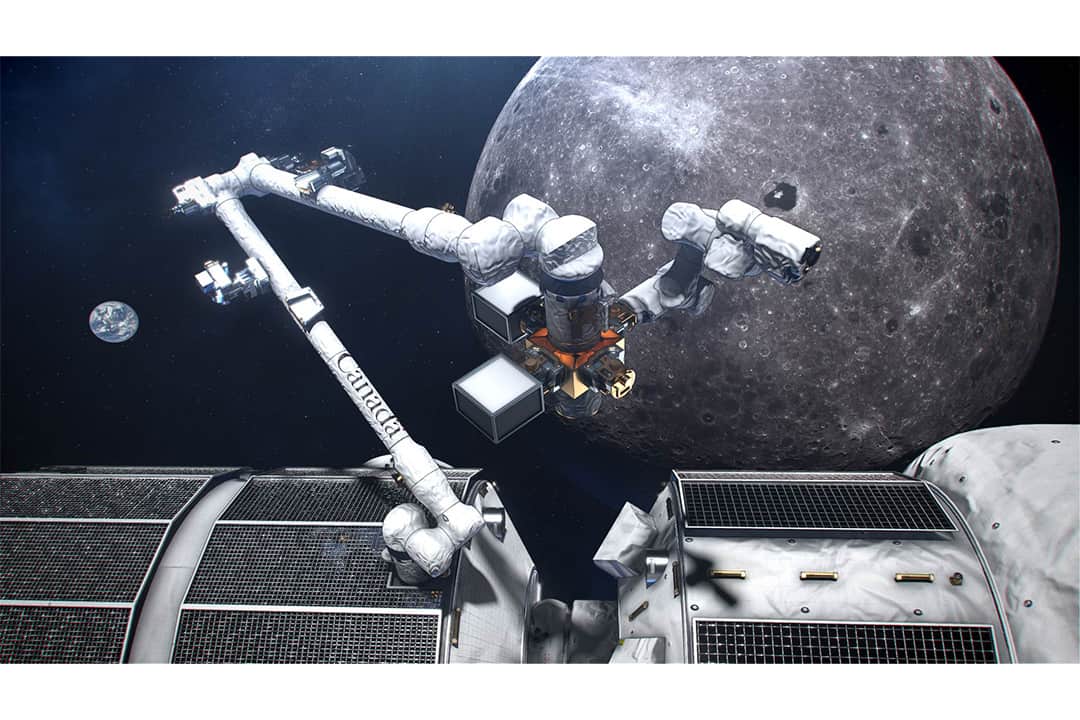Former U of T PhD student Jamil Shariff is one of the brains behind the Canadian Space Agency (CSA)’s new contribution to international space exploration: Canadarm3.
Canadarm3 is an autonomous system consisting of two robotic arms that will be attached to NASA’s Gateway space station, a lunar outpost that will also host a human presence.
This mission marks a global stepping stone towards our understanding of lunar science, through an extended view of the moon’s surface that we wouldn’t be able to get from Earth. NASA also hopes that the Gateway space station can act as a stopping point during future Mars voyages.
A history of Canadian robots in space
Canadarm3 is not the CSA’s first endeavour in furthering autonomous space exploration. In fact, it is the latest version of their previously established cosmic robot arm.
The CSA’s journey in this field began in the 1970s when NASA commissioned it to build an autonomous system to unload payload bays — areas in NASA’s space shuttles where cargo is stored. The challenge of creating such a dexterous apparatus resulted in the birth of the original Canadarm.
As the country’s very first robot arm, Canadarm started missions in 1981 and went on to accomplish many more tasks than its initial purpose. It helped send various satellites into orbit, captured drifting satellites for repair, and assisted astronaut spacewalks — when an astronaut gets out of a vehicle in space to conduct experiments, test equipment, and conduct repairs. It even helped assemble the International Space Station (ISS), a large satellite inhabited by astronauts that is in orbit around Earth to facilitate astronomical research.
The system was an engineering marvel; it could lift over 30,000 kilograms using less electricity than a kettle.
While Canadarm eventually took its last flight in 2011 due to NASA’s space shuttle program shutting down, the CSA built a new version of the system: Canadarm2. This 17-metre-long contraption is one of Canada’s contributions to the ISS.
Canadarm2 performs maintenance tasks around the ISS and helps move supplies and astronauts. One of Canadarm2’s most fascinating uses is achieving ‘cosmic catches.’ These maneuvers involve harnessing incoming uncrewed ships from Earth and docking them to the ISS to help distribute supplies. Canadarm2 is also relatively self-sufficient; it can replace its parts while in space. It is never supposed to return to Earth.
Canadarm3 and its uses
Canadarm3 will be part of a milestone in space exploration due to its contribution to the Gateway space station.
The Gateway space station is set to launch in 2025, with Canadarm3 joining the station in 2028. The Gateway will be the first space station in lunar orbit — a repeating path circling the moon. It can stay in orbit around the moon as long as the station’s momentum and the moon’s gravitational force are balanced.
By Newton’s first law, an object will continue its motion forward unless another object exerts a force on it. Provided that the Gateway’s forward motion isn’t too strong, it will also experience gravity from the moon pulling it to the lunar surface. The tug between the station’s momentum and the moon’s gravity is what enables the Gateway to continue circling the moon.
Putting the Gateway into a lunar orbit is quite a challenging task, especially because it is hard for the station to gain enough forward momentum from its velocity to prevent itself from succumbing to the gravitational pull of the moon. The cost of the resources needed to accomplish this warrants a question: why do we even want to put the Gateway into lunar orbit?
Primarily, the Gateway will facilitate the observation of the lunar surface, which can foster further breakthroughs in space science.
Moreover, as we consider the possibility of more humans travelling beyond our planet, it is crucial for us to understand the health effects of being outside the Earth’s magnetic field. The field — produced in the Earth’s interior due to many factors like its fast rotation — is what shields us from harmful substances, such as the sun’s charged particles that can erode atmospheres. The Gateway space station will act as a testbed for new technologies outside the Earth’s magnetic field, will help facilitate exploration of the surface of the Moon, and will act as a stepping stone for future missions to Mars.
Canadarm3 will help facilitate many vital tasks aboard the Gateway. Similar to previous iterations of Canadarm, Canadarm3 will also aid with maintenance and vehicle management, while continuing to ‘catch’ vehicles arriving at the station. Its highly autonomous nature means it will also reduce the requirement for astronaut spacewalks, but it will still assist with these activities if they are to occur.
The CSA writes on its website that advancements in AI might mean that Canadarm3 can also perform non-manual tasks, such as optimizing resource use or helping with mission planning.
Canadarm3’s future beyond outer space
In exchange for contributing to NASA’s Gateway mission, the CSA will be able to conduct certain commercial space activities and scientific demonstrations from the station. Canada will also be able to send two astronauts to the moon.
In fact, Canada will have an important role on the Artemis II mission, the first piloted mission to the moon since 1972. Jeremy Hansen will be a part of the crew of Artemis II and will be the first Canadian astronaut to fly to the moon.
The Canadarm robots not only contribute to increasing Canadian presence beyond Earth and signify progress in our efforts to deepen our knowledge of the universe, but they also mark advancements in robotics that can significantly benefit our life on Earth. The technology used in these systems has helped advance healthcare and robotics amongst other fields. For example, Canadarm led to the development of neuroArm, which is the first robot that can perform neurosurgery inside an MRI machine.



No comments to display.